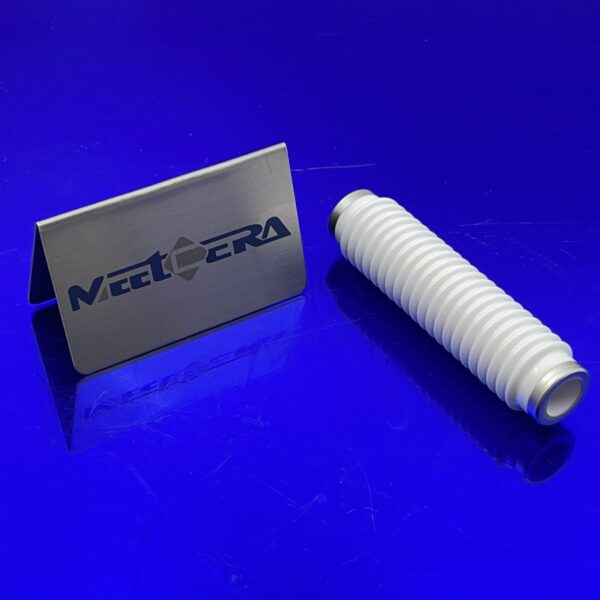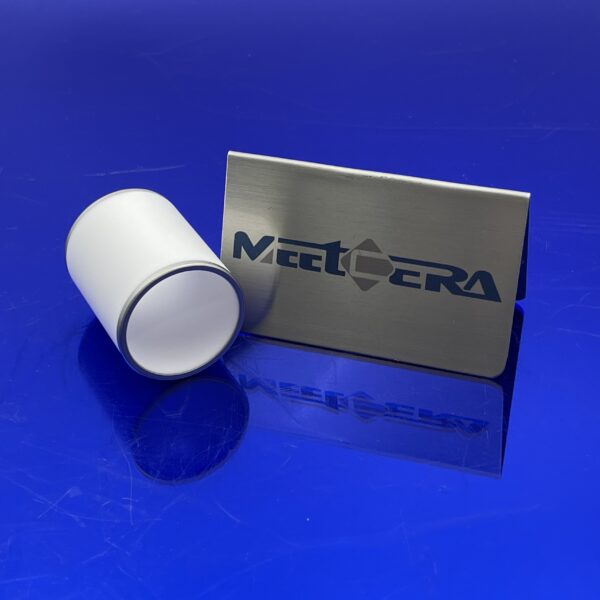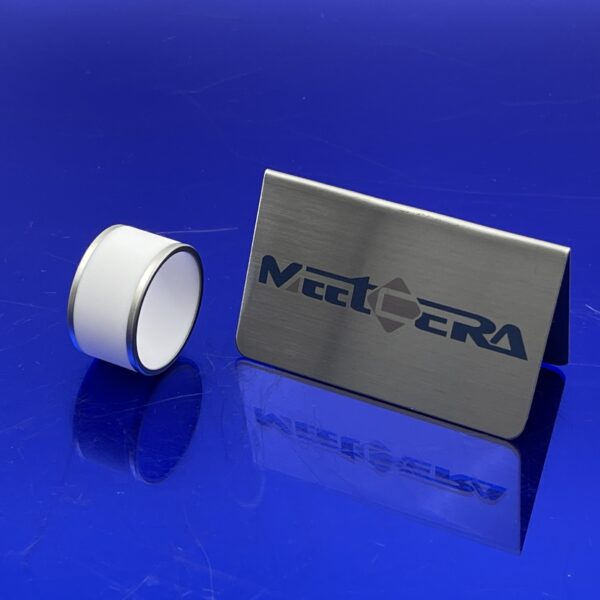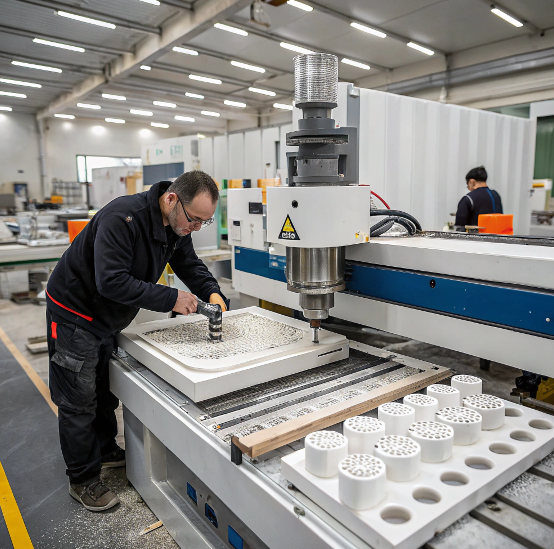What Products and Applications Can Be Made Using Metallized Ceramic Components?
People often ask about the practical uses of advanced materials like metallized ceramics. They hear about the technology and services, but they want to know, "Metallized components can make those?" They are asking about the actual products and applications that are made possible or significantly improved by using components made from metallized ceramics or ceramic-to-metal joint1s. The answer is yes, these specialized components are key building blocks for a wide range of high-performance products across many demanding industries. This article details the types of products and applications that are enabled by metallized ceramic components.
Can you make hermetically sealed electronic packages?
Can sensitive electronic chips be reliably protected from moisture, contaminants, and environmental factors using packaging made possible by metallized components?
This is a problem because standard plastic packaging offers limited protection against moisture and chemicals, particularly over long periods or in challenging environments. It often struggles with high operating temperatures and has relatively poor thermal conductivity compared to ceramics. Relying on plastic packaging for sensitive or high-reliability electronic chips leads to device failure caused by environmental ingress (like moisture leading to corrosion), limits device performance due to inadequate heat dissipation, and prevents use in critical high-reliability applications requiring guaranteed environmental sealing (hermeticity).
Yes, metallized ceramic components2, used as bases, lids, and side walls for electronic packages, can make highly reliable, hermetic packages. The ceramic provides insulation and heat management, and the metallization enables these parts to be brazed together and to metal leads, creating a completely sealed environment that protects sensitive electronic chips from moisture, gases, and contaminants.
Can you make reliable electrical feedthroughs?
Can electrical signals or power be reliably passed through a sealed barrier, such as the wall of a vacuum system, a high-pressure vessel, or a high-temperature enclosure, while maintaining the integrity of the barrier?
This is a problem because simply running wires through holes or standard connectors can compromise the seal of the barrier, whether it is maintaining a vacuum or containing pressure. These basic methods can lead to leaks, loss of vacuum or pressure, or create pathways for electrical shorts. Standard feedthroughs made from other materials may not withstand high temperatures, harsh chemicals, or the stresses required for long-term reliability in demanding sealed systems, leading to system failure or safety risks.
Yes, metallized ceramic components, often in configurations like tubes, discs with metallized rings, or multi-pin headers, can make highly reliable electrical feedthroughs. They combine the electrical insulation properties of the ceramic with the ability enabled by metallization to be hermetically brazed into metal housings, allowing electrical signals or power to cross a sealed barrier while maintaining both electrical isolation and perfect seal integrity.
Can you make high power and high frequency substrates3?
Can substrates for high-power or high-frequency electronic circuits provide both excellent electrical insulation and efficient heat dissipation, along with precise conductive patterns?
This is a problem because standard organic printed circuit board (PCB) materials, while cost-effective, have limitations in managing heat from high-power chips and can suffer from signal integrity issues at very high frequencies due to material properties and limitations in creating very fine, precise traces. Relying solely on them for power electronics or advanced RF circuits leads to components overheating (reducing performance and lifespan), requires larger form factors for cooling, and can limit the speed and clarity of electrical signals, preventing the development of compact, high-performance electronic modules.
Yes, metallized ceramic components, in the form of substrates (commonly made from Alumina or Aluminum Nitride) with precision metallized patterns, can make high-performance electronic substrates. The ceramic base provides excellent electrical insulation and high thermal conductivity for efficient heat dissipation, while the precision metallization enables the creation of fine, accurate conductive traces necessary for high-density interconnections and high-frequency electronic circuits.
CTE Management:
| Material | CTE (10⁻⁶/°C) | Mating Metal |
|---|---|---|
| Al₂O₃ (96%) | 7.8 | Kovar |
| AlN | 4.5 | Molybdenum |
| BeO | 7.2 | Titanium |
Are You Finding It Difficult to Achieve a Strong Ceramic-to-Metal Joint?
Engineers and manufacturers working with ceramic-to-metal components for critical applications often face a key challenge: ensuring the joint between the ceramic and the metal is consistently strong and reliable. It is a common question we encounter: "Are you finding it difficult to achieve a strong ceramic-to-metal joint?" The honest answer is yes, achieving a consistently strong ceramic-to-metal joint presents significant technical difficulties. It is not a simple task due to the fundamental differences between these material types. However, these difficulties are well-understood challenges in the field, and they can be successfully overcome with the right expertise, materials, and processes. This article discusses the primary reasons why achieving a strong ceramic-to-metal joint is challenging and how those difficulties are addressed.
Can you manage the pressure caused by thermal expansion mismatch?
How does the difference in how ceramics and metals expand and contract with temperature changes make it difficult to achieve and maintain joint strength?
This is a problem because ceramic materials generally have lower Coefficients of Thermal Expansion (CTEs) than metals. When a ceramic-to-metal joint is heated or cooled, the metal component expands or contracts by a different amount than the ceramic component. This difference creates significant mechanical stress – tension, compression, and shear – at the joint interface and within the materials near the joint. If this thermal stress is too high, or if the component undergoes repeated temperature cycles, these stresses can exceed the strength limits of the braze material or the ceramic, leading to crack initiation or fatigue failure in the joint. This makes maintaining joint strength challenging, particularly over wide operating temperature ranges or during thermal shock events.
Yes, managing the stresses caused by the different thermal expansion rates between ceramic and metal is difficult because these stresses can be substantial enough to exceed the strength limits of the joint materials or the ceramic itself, potentially leading to fracture or fatigue failure, particularly under thermal cycling conditions.
| Parameter | Alumina (96%) | Aluminum Nitride |
|---|---|---|
| Thermal Conductivity | 24 W/mK | 180 W/mK |
| Cost (per 100mm²) | $0.85 | $4.20 |
| Signal Loss @ 10GHz | 0.02 dB/cm | 0.005 dB/cm |
This is why careful material pairing with similar CTEs, where possible, and thoughtful joint design are essential; it is about engineering the joint to survive the forces generated by temperature changes.
How to deal with brittleness and defects in ceramics?
How does the inherent brittleness and sensitivity of ceramic materials to small flaws make it difficult to ensure a strong and durable ceramic-to-metal joint?
This is a problem because technical ceramics are characterized by high hardness and compressive strength but are significantly weaker in tension and shear compared to metals. Furthermore, ceramics are brittle materials and are sensitive to small flaws, such as microscopic cracks or pores, which can act as stress concentrators. When tensile or shear stresses are present at the joint interface or in the ceramic near the joint (either from operational loads, residual stress from manufacturing, or thermal mismatch stress), these stresses can easily initiate and propagate cracks from these small flaws in the ceramic, leading to sudden, often catastrophic fracture of the joint or the ceramic component itself. This makes achieving robust joint strength challenging, as the material is unforgiving of tensile stress or defects.
Yes, achieving a consistently strong and durable joint is difficult because ceramic materials are inherently brittle and prone to fracture under tensile or shear stress. Small flaws within the ceramic can act as significant stress concentrators, making the material vulnerable to cracking near the joint area when subjected to various loads.
We know that even a perfect bond won't save a joint if the ceramic cracks. This is why managing stress in the ceramic itself is just as important as the bond strength.
How do I ensure a uniform, defect-free bonding layer?
How do inconsistencies or defects within the joint layer itself make it difficult to achieve consistent and high joint strength?
This is a problem because the joining layer, typically a braze alloy4, and its interfaces with the metallization and the mating metal, must form a continuous, uniform, and defect-free bond across the entire intended joint area to achieve maximum strength. Imperfections such as voids (empty spaces) within the braze, areas of incomplete wetting or bonding, contamination, or the formation of undesirable brittle intermetallic phases at the interfaces act as weak points and stress concentrators within the joint. If the manufacturing process is not perfectly controlled, these flaws can occur, drastically reducing the overall mechanical strength of the joint compared to a flawless bond and leading to unpredictable failure points under load.
Yes, ensuring consistent high joint strength is difficult because manufacturing imperfections, such as voids in the braze material, unbonded areas at the interfaces, or the formation of brittle phases, create weak points within the joint structure that reduce its load-bearing capacity and can lead to premature mechanical failure.
Achieving a perfect, uniform bond layer is a key goal of our process control because any flaw can compromise the strength.
Proving Joint Strength: Testing and Verification
Achieving strength is one thing; proving it consistently is another. Reliable manufacturers verify the mechanical strength of ceramic-to-metal joints5 using various testing methods. These can include:
- Shear Strength Testing: Measuring the force required to cause failure by shearing the joint.
- Tensile Strength Testing: Measuring the force required to pull the joint apart.
- Bend Strength Testing: (Often for substrates) Measuring the load a metallized/brazed ceramic can withstand before bending failure.
- Proof Pressure Testing: (For sealed components) Subjecting the joint to a pressure exceeding its operational requirement to verify its integrity and mechanical resistance.
- Thermal Cycle/Shock Testing: Exposing the joint to repeated temperature changes to evaluate its durability and resistance to thermally induced stresses.
These tests provide objective data to confirm that the joint meets the required strength specifications for the application.
What is the Lifespan and Reliability of Metallized Components?
For engineers and manufacturers who use components in demanding applications, two critical questions always come up: how long will this part last, and can I rely on it not to fail? When considering specialized items like metallized ceramic components and ceramic-to-metal seals, understanding their lifespan and reliability is paramount. Unlike simple parts, these components often operate in harsh conditions where failure can have severe consequences. You need to know: are these components designed for long-term, dependable performance? This article discusses the lifespan and reliability of metallized components, explaining the factors that influence them and how high reliability is achieved.
How Operational Stresses Affect Lifespan?
How do the stresses encountered during operation, such as repeated thermal cycling (heating and cooling), vibration, mechanical loading, and pressure variations, affect how long a ceramic-to-metal joint will last?
This is a problem because these operational stresses, particularly when they occur repeatedly over time, can cause fatigue and gradual degradation in the materials that make up the joint – the ceramic, the metallization layer, and the braze alloy. Over thousands or even millions of operational cycles, microscopic cracks can initiate and grow. This can eventually lead to mechanical failure of the joint or loss of its hermetic seal integrity well before the intended end of the product's life. If the joint cannot reliably withstand these stresses over time, the component will fail prematurely, causing system disruption and requiring costly replacement.
Metallized ceramic components are engineered for a long lifespan by being designed and manufactured to withstand significant operational stresses over extended periods. Through careful material selection (addressing CTE mismatch), robust joint design (managing stress distribution), and controlled processing (minimizing residual stress), we create joints capable of enduring extensive thermal cycling, vibration, and mechanical loads, ensuring predictable performance and durability over many years of service.
| Test Type | Conditions | Equivalent Lifespan |
|---|---|---|
| Thermal Shock | 500 cycles (-196↔450°C) | 25 years in space |
| Vibration | 20Grms, 6h each axis | 100k automotive miles |
| Pressure Cycling | 0↔30k psi, 10⁴ cycles | 15 years subsea |
We know that components in aerospace experience intense vibration and thermal changes; our design and process aim to ensure they survive these stresses for the required mission duration.
How Environmental Factors Impact Reliability?
How do harsh environmental conditions, such as exposure to extreme high or low temperatures, corrosive chemicals, high humidity, or even radiation, affect the long-term reliability and lifespan of metallized ceramic components?
This is a problem because many common engineering materials are susceptible to degradation when exposed to harsh environments over time. Polymers can soften, become brittle, or chemically break down. Metals can corrode, oxidize, or lose strength at high temperatures. If the ceramic material, the metallization layer, the braze alloy, or the mating metal are not specifically resistant to the operational environment, they will degrade, weakening the joint, losing electrical function, or compromising the hermetic seal. This leads to component failure and loss of function in the harsh environment, limiting the product's application range and lifespan.
Metallized ceramic components demonstrate excellent reliability and achieve long lifespans in harsh environments due to the inherent resistance of technical ceramics to high temperatures, corrosive chemicals, and moisture. Combined with carefully selected metallization layers, braze alloys, and mating metals chosen for their compatibility and resistance to the specific environment, the resulting components maintain their integrity and performance over long periods in demanding conditions where less robust components would fail.
Components used in downhole drilling equipment or industrial chemical processing plants need materials that won't degrade in aggressive media; metallized ceramics provide that resistance.
How Manufacturing Quality Influences Lifespan?
How can imperfections or inconsistencies introduced during the manufacturing process negatively affect the long-term reliability and expected lifespan of ceramic-to-metal joints?
This is a problem because manufacturing flaws, such as voids (empty spaces) within the braze layer, unbonded areas at the metallization-ceramic interface, contamination, or excessive residual stress from improper cooling after brazing, act as weak points and potential crack initiation sites within the joint. These defects may not be immediately visible but can grow and propagate under operational stress or thermal cycling, leading to premature failure of the joint well before its intended lifespan. Such failures are often unpredictable, difficult to diagnose, and costly to repair.
High reliability and long lifespan are directly ensured by minimizing manufacturing flaws6 through stringent process control during metallization and brazing. Meticulous surface preparation, precise control over temperature profiles, furnace atmospheres, material application, and cooling rates, coupled with comprehensive in-process quality checks, aim to produce consistently strong, uniform, and defect-free joints, thereby preventing early failures caused by manufacturing imperfections.
Our focus on precise process control is aimed directly at eliminating the hidden defects that could shorten a component's life.
How Material Compatibility Affects Reliability?
How does the compatibility between the different materials used in the ceramic-to-metal joint system (ceramic, metallization, braze alloy, mating metal) influence its lifespan and long-term reliability?
This is a problem because if the materials in the joint system are not carefully selected for compatibility, undesirable reactions can occur during the high-temperature manufacturing process or over time during operation. These can include the formation of brittle intermetallic compounds at interfaces, or galvanic corrosion if exposed to certain environments containing electrolytes. Such material incompatibilities weaken the joint over time and can lead to gradual degradation, delamination, or failure, shortening the component's lifespan and compromising reliability in the intended application.
Long lifespan and high reliability are achieved by carefully selecting materials for the entire joint system – the ceramic material, the metallization type, the braze alloy, and the mating metal – that are compatible with each other and resistant to the application environment. This prevents detrimental intermetallic formation, minimizes residual stress, and avoids electrochemical degradation, ensuring the joint remains stable, strong, and hermetic over long periods of service.
Choosing compatible materials is essential for creating a joint that will maintain its integrity and performance over decades, not just days or months.
How Lifespan and Reliability Are Predicted and Verified?
How do engineers gain confidence in the predicted lifespan and reliability of metallized ceramic components7 before incorporating them into critical applications, and how is this verified?
This is a problem because for critical applications requiring many years or decades of reliable performance (e.g., aerospace components, medical implants, nuclear facility equipment), simply testing a few parts for a short time is insufficient to predict long-term durability accurately. If the predicted lifespan is inaccurate or the reliability is lower than expected, components can fail prematurely, disrupting long-term operational goals, leading to significant financial costs, potential safety issues, and damage to reputation. Confidence requires rigorous scientific methods and testing.
Predicted lifespan and high reliability are verified through rigorous engineering and testing. This includes analyzing material properties and joint design using simulation to predict stress distribution and fatigue life. It crucially involves accelerated life testing8, where components are subjected to stresses (like temperature cycling, vibration, or pressure) beyond normal operating conditions to induce failure more quickly. Extensive thermal cycling tests, mechanical fatigue testing, and long-term hermeticity testing demonstrate durability and provide data to predict performance and verify reliability over the required operational lifespan.
We use accelerated testing and data analysis to predict how our components will perform over many years in the field, providing objective evidence of their reliability.
Why Metallized Ceramics Are Needed for These Applications
These examples demonstrate that metallized ceramic components are not just a niche technology; they are essential building blocks for many advanced products. For these types of demanding applications, standard engineering materials alone simply cannot meet the requirements. Plastics cannot handle high temperatures or provide long-term hermeticity. Most metals are electrically conductive, often corrode in harsh chemicals, and have thermal expansion rates that make joining to ceramics difficult without specialized methods. Metallized ceramics are necessary because they uniquely combine the desirable properties of technical ceramics with the crucial ability to form strong, hermetic bonds to metal parts or to carry electrical signals via precision metallization. This combination of electrical insulation, high-temperature stability, mechanical strength, chemical resistance, and reliable joinability is precisely what enables the performance and reliability needed in these critical applications.
| Enabled Product/Application | Key Properties Provided by Metallized Ceramic Component |
|---|---|
| Hermetic Electronic Packages | Hermeticity, Thermal Management, Electrical Insulation, Mechanical Strength |
| Electrical Feedthroughs | Electrical Insulation, Hermeticity, Pressure/Vacuum Resistance, High Temperature Stability |
| High-Power/High-Frequency Substrates | High Thermal Conductivity, Electrical Insulation, Pattern Precision, Mechanical Strength |
| Vacuum/High-Pressure Components | Hermeticity, Mechanical Strength, Pressure/Vacuum Resistance, Temperature Resistance |
| High-Temp/Harsh Environment Parts | High Temperature Resistance, Chemical Inertness, Mechanical Strength, Durability |
| Medical Implants/Devices | Biocompatibility, Hermeticity, Durability, Electrical Insulation |
| Sensor Housings/Components | Environmental Protection, Electrical Insulation, Hermeticity, Mechanical Strength |
This table summarizes how the unique properties of metallized ceramic components directly enable these diverse applications.
Conclusion
In conclusion, the question "Metallized components can make those?" refers to the wide array of advanced, high-reliability products and applications that are indeed made possible by the unique capabilities of metallized ceramic components and the technology of ceramic-to-metal joining. From hermetic electronic packaging and critical electrical feedthroughs to components operating reliably in vacuum, high pressure, extreme temperatures, or within the human body, metallized ceramics provide an essential combination of electrical, thermal, mechanical, and environmental properties that standard materials often cannot match. By enabling robust metal joining and precise electrical patterns on a ceramic base, these components serve as fundamental building blocks in demanding industries, directly enabling the performance, reliability, and miniaturization required for critical systems and innovative products.
-
Understanding the challenges of ceramic-to-metal joints can help in developing better manufacturing techniques and materials. ↩
-
Explore how metallized ceramic components enhance electronic packaging and reliability, crucial for modern technology. ↩
-
Learn how these substrates enhance performance in electronics, crucial for h ↩
-
Understanding braze alloys is crucial for ensuring strong, reliable joints in demanding applications. Explore this link to learn more. ↩
-
Discover the testing methods used to verify the strength of ceramic-to-metal joints, ensuring their reliability in critical applications. ↩
-
Learn how manufacturing flaws can lead to premature failures in ceramic-to-metal joints, and how to mitigate these risks for better reliability. ↩
-
Explore how metallized ceramic components are crucial for advanced applications, combining unique properties for reliability and performance. ↩
-
Discover the role of accelerated life testing in verifying the reliability of components for critical applications. ↩










No comment